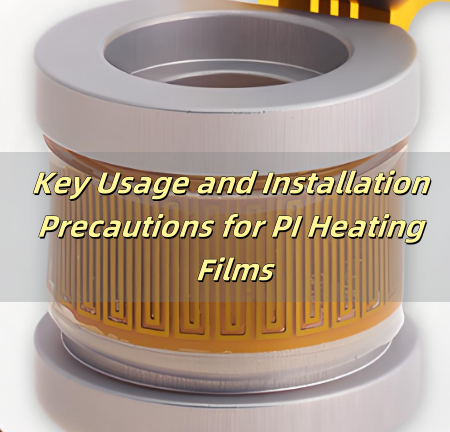PI heating films are known for their thin structure, flexible design, and uniform heat distribution. However, to achieve stable performance and long service life, users must follow specific installation and usage precautions. Even minor mistakes during installation may lead to performance issues or damage. Below are the main points you should always keep in mind.

Each PI heating film is designed for a specific rated voltage, such as 5V, 12V, 24V, or 220V. Operating beyond the rated voltage will cause the surface temperature to rise sharply. This can result in overheating, insulation breakdown, or even film burn-out.
When designing your system, always confirm the input voltage matches the heater’s label. If you need faster heating, increase the power density or use a temperature control module instead of simply raising the voltage. Stable voltage supply is the foundation for safe operation and accurate temperature control.
PI heaters have a multi-layer structure—a copper or etched foil circuit is sandwiched between polyimide insulation layers. This structure offers flexibility but cannot tolerate destructive mechanical stress.
Actions like pulling, twisting, or sharply folding the heater can break internal circuits, leading to open circuits or localized overheating.
During installation, gently handle the film. Do not stretch or fold it. If the design requires curvature, ensure the bending radius is large enough to maintain circuit integrity.
For high-voltage PI heaters, the insulation strength of the outer surface is critical. The protective layer must remain intact to prevent electrical leakage or surface breakdown.
Do not pierce or scratch the insulation film, especially around terminal areas. Any small damage may cause leakage current or short circuits when voltage is applied.
When installing, inspect the insulation visually and avoid contact with sharp tools or metallic objects.
If the heater operates in a humid or dusty environment, consider adding an extra insulation layer or a protective silicone sheet to further reduce risk.
A PI heating film transfers heat efficiently only when it is fully and evenly bonded to the surface. Air gaps between the heater and the substrate cause poor heat transfer, which can lead to dry heating and localized high temperatures.
Before applying the heater, clean the bonding surface to remove dust, oil, or uneven textures. Use heat-resistant adhesive or pressure-sensitive tape for secure attachment.
When pressing the heater in place, apply even force from the center outward to expel trapped air. The flatter the bond, the more uniform the heat distribution.
Though PI heaters can reach high temperatures quickly, continuous heating without control can shorten their lifespan. Using temperature sensors, thermistors, or thermostats helps regulate temperature precisely.
For high-power applications, a PID controller can manage temperature rise smoothly, preventing overshoot and maintaining steady performance.
Always place the temperature sensor close to the heating zone for accurate feedback.
PI heaters should not be powered when not in contact with a surface. Dry heating means the generated heat has nowhere to go, which may damage the heater or surrounding components.
If you must test the heater without bonding, limit the power-on duration to a few seconds and use a lower voltage. Continuous dry operation is unsafe and can lead to thermal degradation.
Incorrect or loose wiring may cause resistance changes, voltage drops, or unstable heating. Before connecting the power, verify that:
A stable connection ensures consistent heating and prevents short circuits.
Install the PI heater in a dry, clean, and vibration-free environment. Dust, moisture, or oil residue can affect adhesive performance and insulation quality. Avoid exposure to solvents or chemicals that may erode the polyimide layer.
If used in outdoor or humid conditions, sealing the heater with a silicone or epoxy coating improves reliability and water resistance.
So in a word, correct installation and careful use directly affect the efficiency, safety, and durability of PI heating films.
Always stay within the rated voltage, maintain smooth contact surfaces, and protect the insulation layer from physical or electrical damage.
At Danyu electronics, we design and produce custom PI heating films tailored for industrial, medical, and consumer applications. Our products undergo strict electrical safety tests, insulation checks, and uniform heating verification before shipment. With our engineering support, you can achieve consistent temperature control and reliable performance for years.
1. Can I reuse a PI heating film after removal?
It’s not recommended. Once a PI heater is peeled off, the adhesive surface may lose bonding strength, and the circuit might get damaged. Always use a new unit for reliable heating.
2. What adhesive is suitable for PI heater installation?
Use heat-resistant silicone adhesive or 3M high-temperature double-sided tape. Avoid low-temperature glue that can soften or release gas during heating.
3. How should I clean the surface before applying a PI heater?
Wipe the surface with isopropyl alcohol or a clean dry cloth to remove oil, dust, and moisture. A smooth and dry surface helps achieve strong adhesion.
4. Can I cut or trim a PI heating film?
No. PI heaters are made with fixed etched circuits. Cutting or trimming may break the internal conductor and cause malfunction or electrical hazards.
5. What happens if the heater gets wet during operation?
Moisture may lead to insulation failure or short circuits. If the heater is exposed to water, disconnect power immediately and dry it completely before reuse. For humid environments, consider sealed or silicone-encapsulated PI heaters.
Simply drop your email or phone number in the contact form, and we'll promptly reply you shortly.